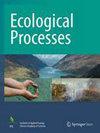Functional and phylogenetic structure of mammals along elevational gradients in the Central and East Himalayas
IF 3.9
2区 环境科学与生态学
Q1 ECOLOGY
引用次数: 0
Abstract
Mountain ecosystems are critical hotspots of global biodiversity, yet the dynamics of community assembly along their elevational gradients are not well understood. This gap is primarily due to the complexity of environmental and biotic interactions that influence species distribution and community structure. Although extensive research has been conducted on certain taxa, such as small mammals and bats, comprehensive studies encompassing entire mammal assemblages are lacking. Our research aims to bridge this gap by examining the taxonomic, phylogenetic, and functional diversity, as well as the assemblage structures of mammal communities across elevational gradients in the Central and East Himalayas, exploring how diverse ecological and evolutionary processes impact community assembly. We analyzed mammal elevational diversity patterns using species richness, functional diversity (FD), and phylogenetic diversity (PD). We compared the observed values of community structure, such as mean pairwise phylogenetic distance (MPD) and mean pairwise functional distance (MFD), with null-model corrected effect sizes to identify patterns and processes of community assembly. Using structural equation modeling and hierarchical partitioning, we investigated the relationships between climate, productivity, and various facets of diversity, describing the organization of each component across different elevations. Taxonomic, functional, and phylogenetic diversity generally decreased with elevation but showed varied patterns such as mid-elevation peaks, low-elevation plateaus, or monotonic declines across different regions. Richness-controlled functional diversity increased towards mid-low elevations and decreased at higher elevations in both regions, whereas richness-controlled phylogenetic diversity lacked consistent patterns. Phylogenetic structures tended to cluster from mid to high elevations, indicating closer relationships than those observed in random communities, likely due to significant environmental turnover near tree lines. Functional structure showed greater clustering at high elevations and increased over-dispersion at lower elevations, suggesting that species are more functionally similar than expected at higher elevations and more diverse at lower elevations. Our results revealed that environmental factors, evolutionary histories, and trait-driven ecological processes collectively shape species richness along these gradients. Our results showed incongruent community structures across phylogenetic and functional diversity. Generally, functional traits are closely linked to environmental conditions, reducing the chance of observing traits that are misaligned with their surroundings. Species with similar ecological roles or distinct evolutionary lineages often show convergent adaptations to highland environments. Additionally, our findings emphasize that community assembly varies with the biogeography and diversification history of individual mountain ranges, complicating the development of a generalized theory. Using multiple measures is important for accurate community structure assessments and effective conservation planning, as variable elevational patterns exist across different diversity dimensions.喜马拉雅山脉中部和东部沿海拔梯度哺乳动物的功能和系统发育结构
山地生态系统是全球生物多样性的重要热点,但人们对其海拔梯度上群落组合的动态并不十分了解。造成这一空白的主要原因是影响物种分布和群落结构的环境和生物相互作用非常复杂。虽然对某些类群(如小型哺乳动物和蝙蝠)进行了广泛的研究,但还缺乏对整个哺乳动物群落的全面研究。我们的研究旨在通过考察喜马拉雅山脉中部和东部不同海拔梯度的哺乳动物群落的分类、系统发育和功能多样性以及群落结构,探索不同的生态和进化过程如何影响群落的组合,从而弥补这一空白。我们利用物种丰富度、功能多样性(FD)和系统发育多样性(PD)分析了哺乳动物的海拔多样性模式。我们将观察到的群落结构值(如平均成对系统发育距离(MPD)和平均成对功能距离(MFD))与空模型校正效应大小进行了比较,以确定群落组合的模式和过程。利用结构方程建模和分层划分法,我们研究了气候、生产力和多样性各方面之间的关系,并描述了不同海拔地区各组成部分的组织情况。分类、功能和系统发育多样性一般随着海拔的升高而降低,但在不同地区表现出不同的模式,如中海拔高峰、低海拔高原或单调下降。在这两个地区,由丰富度控制的功能多样性在中低海拔地区增加,在高海拔地区减少,而由丰富度控制的系统发育多样性则缺乏一致的模式。系统发育结构趋向于在中高海拔地区集群,表明其关系比随机群落中观察到的关系更为密切,这可能是由于树线附近环境的显著变化所致。功能结构在高海拔地区显示出更大的聚集性,而在低海拔地区则显示出更大的过度分散性,这表明在高海拔地区物种的功能比预期的更加相似,而在低海拔地区则更加多样化。我们的研究结果表明,环境因素、进化历史和性状驱动的生态过程共同塑造了这些梯度上的物种丰富度。我们的研究结果表明,系统发育和功能多样性的群落结构并不一致。一般来说,功能性状与环境条件密切相关,这就减少了观察到性状与周围环境不一致的机会。具有相似生态作用或不同进化世系的物种往往会对高原环境表现出趋同的适应性。此外,我们的研究结果还强调,群落的组合随各个山脉的生物地理学和多样化历史而变化,这使得建立一个普遍的理论变得更加复杂。使用多种测量方法对于准确评估群落结构和有效制定保护规划非常重要,因为在不同的多样性维度上存在着不同的海拔模式。
本文章由计算机程序翻译,如有差异,请以英文原文为准。
求助全文
约1分钟内获得全文
求助全文
来源期刊

Ecological Processes
Environmental Science-Ecological Modeling
CiteScore
8.50
自引率
4.20%
发文量
64
审稿时长
13 weeks
期刊介绍:
Ecological Processes is an international, peer-reviewed, open access journal devoted to quality publications in ecological studies with a focus on the underlying processes responsible for the dynamics and functions of ecological systems at multiple spatial and temporal scales. The journal welcomes manuscripts on techniques, approaches, concepts, models, reviews, syntheses, short communications and applied research for advancing our knowledge and capability toward sustainability of ecosystems and the environment. Integrations of ecological and socio-economic processes are strongly encouraged.
 求助内容:
求助内容: 应助结果提醒方式:
应助结果提醒方式:


